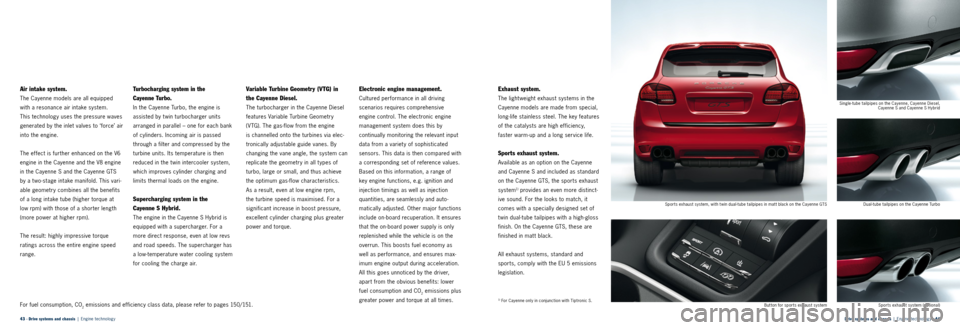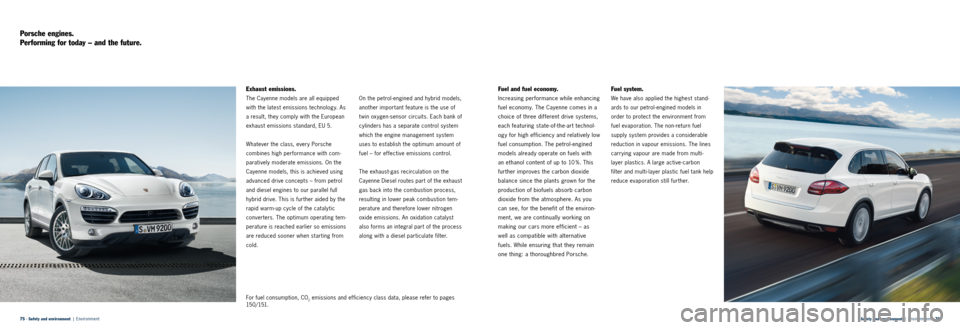fuel filter PORSCHE CAYNNE 2013 2.G Information Manual
[x] Cancel search | Manufacturer: PORSCHE, Model Year: 2013, Model line: CAYENNE, Model: PORSCHE CAYENNE 2013 2.GPages: 79, PDF Size: 14.97 MB
Page 22 of 79

Drive systems and chassis | Engine technology · 44
43 · Drive systems and chassis | Engine technology
Air intake system.
The Cayenne models are all equipped
with a resonance air intake system.
This technology uses the pressure waves
generated by the inlet valves to ‘ force’ air
into the engine.
The effect is further enhanced on the V6
engine in the Cayenne and the V8 engine
in the Cayenne S and the Cayenne GTS
by a t wo -stage intake manifold. This vari -
able geometry combines all the benefits
of a long intake tube (higher torque at
low rpm) with those of a shorter length
(more power at higher rpm).
The result: highly impressive torque
ratings across the entire engine speed
range.
Turbocharging system in the
Cayenne Turbo.
In the Cayenne Turbo, the engine is
assisted by t win turbocharger units
arranged in parallel – one for each bank
of cylinders. Incoming air is passed
through a filter and compressed by the
turbine units. Its temperature is then
reduced in the twin intercooler system,
which improves cylinder charging and
limits thermal loads on the engine.
Supercharging system in the
Cayenne S Hybrid.
The engine in the Cayenne S Hybrid is
equipped with a supercharger. For a
more direct response, even at low revs
and road speeds. The supercharger has
a low-temperature water cooling system
for cooling the charge air.
Variable Turbine Geometry (VTG) in
the Cayenne Diesel.
The turbocharger in the Cayenne Diesel
features Variable Turbine Geometry
(V TG). The gas-flow from the engine
is channelled onto the turbines via elec -
tronically adjustable guide vanes. By
changing the vane angle, the system can
replicate the geometry in all t ypes of
turbo, large or small, and thus achieve
the optimum gas-flow characteristics.
As a result, even at low engine rpm,
the turbine speed is maximised. For a
significant increase in boost pressure,
excellent cylinder charging plus greater
power and torque.
Electronic engine management.
Cultured performance in all driving
scenarios requires comprehensive
engine control. The electronic engine
management system does this by
continually monitoring the relevant input
data from a variet y of sophisticated
sensors. This data is then compared with
a corresponding set of reference values.
Based on this information, a range of
key engine functions, e.g. ignition and
injection timings as well as injection
quantities, are seamlessly and auto -
matically adjusted. Other major functions
include on-board recuperation. It ensures
that the on-board power supply is only
replenished while the vehicle is on the
overrun. This boosts fuel economy as
well as performance, and ensures max -
imum engine output during acceleration.
All this goes unnoticed by the driver,
apart from the obvious benefits: lower
fuel consumption and CO
2 emissions plus
greater power and torque at all times.
Exhaust system.
The light weight exhaust systems in the
Cayenne models are made from special,
long-life stainless steel. The key features
of the catalysts are high efficiency,
faster warm-up and a long service life.
Sports exhaust system.
Available as an option on the Cayenne
and Cayenne S and included as standard
on the Cayenne GTS, the sports exhaust
system
1) provides an even more distinct -
ive sound. For the looks to match, it
comes with a specially designed set of
t win dual-tube tailpipes with a high-gloss
finish. On the Cayenne GTS, these are
finished in mat t black.
All exhaust systems, standard and
sports, comply with the EU 5 emissions
legislation.
1) For Cayenne only in conjunction with Tiptronic S. Single-tube tailpipes on the Cayenne, Cayenne Diesel,
Cayenne S and Cayenne S Hybrid
Dual-tube tailpipes on the Cayenne Turbo
Sports exhaust system (optional)
But ton for spor ts exhaust system
Spor ts exhaust system, with t win dual -tube tailpipes in mat t black on the Cayenne GTS For fuel consumption, CO2 emissions and efficiency class data, please refer to pages 150/151.
Page 38 of 79

Safety and environment | Environment · 76
75 · Safety and environment | Environment
Exhaust emissions.
The Cayenne models are all equipped
with the latest emissions technology. As
a result, they comply with the European
exhaust emissions standard, EU 5.
Whatever the class, every Porsche
combines high performance with com -
paratively moderate emissions. On the
Cayenne models, this is achieved using
advanced drive concepts – from petrol
and diesel engines to our parallel full
hybrid drive. This is further aided by the
rapid warm-up cycle of the catalytic
converters. The optimum operating tem -
perature is reached earlier so emissions
are reduced sooner when starting from
cold. On the petrol- engined and hybrid models,
another important feature is the use of
t win oxygen-sensor circuits. Each bank of
cylinders has a separate control system
which the engine management system
uses to establish the optimum amount of
fuel – for effective emissions control.
The exhaust-gas recirculation on the
Cayenne Diesel routes part of the exhaust
gas back into the combustion process,
resulting in lower peak com bustion tem-
perature and therefore lower nitrogen
oxide emissions. An oxidation catalyst
also forms an integral part of the process
along with a diesel particulate filter.
Porsche engines.
Performing for today – and the future.
Fuel and fuel economy.
Increasing performance while enhancing
fuel economy. The Cayenne comes in a
choice of three different drive systems,
each featuring state-of-the-art technol -
ogy for high efficiency and relatively low
fuel consumption. The petrol-engined
models already operate on fuels with
an ethanol content of up to 10 %. This
further improves the carbon dioxide
balance since the plants grown for the
production of biofuels absorb carbon
dioxide from the atmosphere. As you
can see, for the benefit of the environ
-
ment, we are continually working on
making our cars more efficient – as
well as compatible with alternative
fuels. While ensuring that they remain
one thing: a thoroughbred Porsche.
Fuel system.
We have also applied the highest stand -
ards to our petrol- engined models in
order to protect the environment from
fuel evaporation. The non-return fuel
supply system provides a considerable
reduction in vapour emissions. The lines
carrying vapour are made from multi-
layer plastics. A large active-carbon
filter and multi-layer plastic fuel tank help
reduce evaporation still further.
For fuel consumption, CO
2 emissions and efficiency class data, please refer to pages
15 0/ 151.
Page 39 of 79

Safety and environment | Environment · 78
77 · Safety and environment | Environment
Noise.
As paradoxical as it may seem, the
distinctive Porsche sound is also created
by what you don’t hear – the absence of
unwanted noise. Naturally, its main origin
is deep within the engine. But that ’s
not all. Our holistic approach to vehicle
design also extends to the acoustics.
Which is why we’ve optimised them for
the entire car.
To minimise ‘play’ between components,
we’ve used stronger, lighter and more
temperature-resistant materials. This
reduces mechanical noise. Large-volume
silencers and air intake manifolds also
help to eliminate noise – throughout the
life of the car.
Tyre noise has been drastically reduced
in collaboration with our official t yre
partners. Wind noise levels have also
been lowered thanks to aerodynamic
refinements. All that remains is a sound that is pure
Porsche.
Servicing.
With lengthy service intervals and long-
life components, vehicle maintenance is
kept to a minimum. In the case of the oil
filter, for example, all that ’s replaced is
an easily recyclable paper element. The
oil filter casing remains on the car.
All moving parts inside the engine are
fully self-adjusting. The valve clearances,
for instance, feature automatic hydraulic
control.
Thanks to single-spark coils on each of
the cylinders, the entire ignition system
on the petrol-engined models, with
the exception of the spark plugs, is
maintenance-free.
These modest service requirements
mean less waste disposal and fewer demands on natural resources. They
also lower the cost of ownership while
keeping your car on the road.
Service intervals for the Cayenne models
are dependent on a range of factors,
including local fuel quality. For full details
of service intervals in your country, please
consult the relevant price list or contact
your Porsche Centre.
Materials and recycling.
Owning a Porsche should be a lasting
pleasure with minimal impact on the
environment. This Porsche principle
can be summed up in one word: sustain -
abilit y. The light weight exhaust on the
Cayenne models, for example, is con -
structed from long-life stainless steel.
Every Porsche model is entirely free of
CFCs and components manufactured
using CFCs. All legal requirements in
respect of recoverability are fulfilled.
Materials are clearly labelled for
subsequent identification and sorting
to facilitate efficient recycling.
While more than 95 % of the car can be
recycled using current technologies, the
chances are your Cayenne may never
need
recycling at all. After all, t wo thirds
of all the cars we have ever made are
still on the road today.
For more information on environmental
issues, please visit www.porsche.com